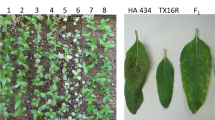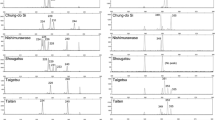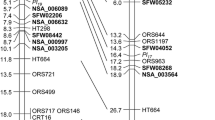Abstract
White clover (Trifolium repens L.) is a forage legume of considerable economic importance in temperate agricultural systems. It has a strong self-incompatibility system. The molecular basis of self-incompatibility in T. repens is unknown, but it is under the control of a single locus, which is expressed gametophytically. To locate the self-incompatibility locus (S locus) in T. repens, we carried out cross-pollination experiments in an F1 mapping population and constructed a genetic linkage map using amplified fragment length polymorphism and simple sequence repeat markers. As the first step in a map-based cloning strategy, we locate for the first time the S locus in T. repens on a genetic linkage map, on the homoeologous linkage group pair 1 (E), which is broadly syntenic to Medicago truncatula L. chromosome 1. On the basis of this syntenic relationship, the possibility that the S locus may or may not possess an S-RNase gene is discussed.

Similar content being viewed by others
References
Abberton MT (2007) Interspecific hybridization in the genus Trifolium. Plant Breed 126:337–342
Abberton MT, Marshall AH (2005) Progress in breeding perennial clovers for temperate agriculture. J Agr Sci 143:117–135
Allen AM, Hiscock SJ (2008) Evolution and phylogeny of self-incompatibility systems in angiosperms. In: Franklin-Tong VE (ed) Self-incompatibility in flowering plants: evolution, diversity and mechanisms. Springer Verlag, Berlin, pp 73–101
Altinkut A, Kazan K, Gozukirmizi N (2003) AFLP marker linked to water-stress-tolerant bulks in barley (Hordeum vulgare L.). Genet Mol Biol 26:77–82
Anderson MA, Cornish EC, Mau S-L, Williams EG, Hogart R, Atkinson A, Bonig I, Grego B, Simpson R, Roche PJ, Haley JD, Penschow JD, Niall HD, Tregar GW, Coghlan JP, Crawford RJ, Clarke AE (1986) Cloning of cDNA for a stylar glycoprotein associated with expression of self-incompatibility in Nicotiana alata. Nature 321:38–44
Arroyo MTK (1981) Breeding systems and pollination biology in Leguminosae. In: Polhill RM, Raven PH (eds) Advances in legume systematics. Royal Botanic Gardens, Kew, pp 723–769
Atwood SS (1940) Genetics of cross-incompatibility among self-incompatible plants of Trifolium repens. J Am Soc Agron 32:955–968
Atwood SS (1941) Cytological basis for incompatibility in Trifolium repens. Am J Bot 28:551–557
Atwood SS (1942) Oppositional alleles causing cross-incompatibility in Trifolium repens. Genetics 27:333–338
Atwood SS (1944) Oppositional alleles in natural populations of Trifolium repens. Genetics 29:428–435
Atwood SS, Hill HD (1940) The regularity of meiosis in microsporocytes of Trifolium repens. Am J Bot 27:730–735
Badr A, Sayed-Ahmed H, El-Shanshouri A, Watson LE (2002) Ancestors of white clover (Trifolium repens L.), as revealed by isozyme polymorphisms. Theor Appl Genet 106:143–148
Barrett B, Griffiths A, Schreiber M, Ellison N, Mercer C, Bouton J, Ong B, Forster J, Sawbridge T, Spangenberg G, Bryan G, Woodfield D (2004) A microsatellite map of white clover. Theor Appl Genet 109:596–608
Barth S, Gonzales M, Febrer M, Connolly V (2004) Molecular genetic diversity within and among Irish ecotypes of perennial ryegrass and white clover collected from old pastures. In: Vollmann J, Grausgruber H, Ruckenbauer P (eds) Genetic variation for plant breeding: proceedings of the 17th Eucarpia General Congress. BOKU, Vienna p 162
Bennett MD, Leitch IJ (2003) Angiosperm DNA C-values database. Royal Botanic Gardens, Kew. http://data.kew.org/cvalues/CvalServlet?querytype=2. Accessed 15 January 2010
Benson G (1999) Tandem repeats finder: a program to analyze DNA sequences. Nucleic Acids Res 27:573–580
Benson DA, Karsch-Mizrachi I, Lipman DJ, Ostell J, Wheeler DL (2008) GenBank. Nucleic Acids Res 36:D25–D30
Brewbaker JL (1953) Oppositional allelism in diploid and autotetraploid Trifolium hybridum L. Genetics 38:444–455
Brewbaker JL (1954) Incompatibility in autotetraploid Trifolium repens L. I. Competition and self-compatibility. Genetics 39:307–315
Brewbaker JL (1957) Pollen cytology and self-incompatibility systems in plants. J Hered 48:271–277
Doyle JJ, Doyle JL (1987) A rapid total DNA preparation procedure for small quantities of fresh leaf tissue. Phytochem Bull 19:11–15
East EM (1934) Norms of pollen tube growth in incompatible matings of self-sterile plants. P Natl Acad Sci USA 20:225–230
Ellison NW, Liston A, Steiner JJ, Williams WM, Taylor NL (2006) Molecular genetics of the clover genus (Trifolium: Leguminosae). Mol Phylogenet Evol 39:688–705
Entani T, Iwano M, Shiba H, Takayama S, Fukui K, Isogai A (1999) Centromeric localizaton of an S-RNase gene in Petunia hybrida Vilm. Theor Appl Genet 99:391–397
ERA-NET plant genomics (2009) Research programme report. http://www.erapg.org/downloadattachment/19018/ERA-NET%20PG%20Report%20LR.pdf. Accessed 15 January 2010
Febrer M, Cheung F, Town CD, Cannon SB, Young ND, Abberton MT, Jenkins G, Milbourne D (2007) Construction, characterization and preliminary BAC-end sequencing analysis of a bacterial artificial chromosome library of white clover (Trifolium repens L.). Genome 50:412–421
Feldman M, Levy AA (2005) Allopolyploidy: a shaping force in the evolution of wheat genomes. Cytogenet Genome Res 109:250–258
Frame J, Charlton JFL, Laidlaw AS (1998) Temperate forage legumes. CABI Publishing, Wallingford
George J, Sawbridge TI, Cogan NOI, Gendall AR, Smith KF, Spangenberg GC, Forster JW (2008) Comparison of genome structure between white clover and Medicago truncatula supports homoeologous group nomenclature based on conserved synteny. Genome 51:905–911
Griffin PC, Woodrow IE, Newbigin EJ (2009) Population genetics of Ryparosa kurranigii (Achariaceae), a rare lowland rainforest tree. Biochem Syst Ecol 37:334–340
Hand ML, Ponting RC, Drayton MC, Lawless KA, Cogan NOI, Brummer EC, Sawbridge TI, Spangenberg GC, Smith KF, Forster JW (2008) Identification of homologous, homoeologous, and paralogous sequence variants in an outbreeding allopolyploid species based on comparison with progenitor taxa. Mol Genet Genomics 280:293–304
Heslop-Harrison J, Heslop-Harrison Y (1982) Pollen–stigma interaction in the Leguminosae: constituents of the stylar fluid and stigma secretion of Trifolium pratense L. Ann Bot 49:729–735
Heslop-Harrison Y, Shivanna KR (1977) Receptive surface of angiosperm stigma. Ann Bot 41:1233–1258
Igic B, Kohn JR (2001) Evolutionary relationships among self-incompatibility RNases. Proc Natl Acad Sci USA 98:13167–13171
Ikeda K, Ushijima K, Yamane H, Tao R, Hauck NR, Sebolt AM, Iezzoni AF (2005) Linkage and physical distances between the S-haplotype S-RNase and SFB genes in sweet cherry. Sex Plant Reprod 17:289–296
Jones ES, Hughes LJ, Drayton MC, Abberton MT, Michaelson-Yeates TPT, Bowen C, Forster JW (2003) An SSR and AFLP molecular marker-based genetic map of white clover (Trifolium repens L.). Plant Sci 165:531–539
Kusaba M, Dwyer K, Hendershot J, Vrebalov J, Nasrallah JB, Nasrallah ME (2001) Self-incompatibility in the genus Arabidopsis: Characterization of the S locus in the outcrossing A. lyrata and its autogamous relative A. thaliana. Plant Cell 13:627–643
Lawrence MJ (1975) The genetics of self-incompatibility in Papaver rhoeas. P R Soc Lond B Bio 188:275–285
Lawrence MJ (1996) Number of incompatibility alleles in clover and other species. Heredity 76:610–615
Leduc N, Douglas GC, Monnier M, Connolly V (1990) Pollination in vitro: effects on the growth of pollen tubes, seed set and gametophytic self-incompatibility in Trifolium pratense L. and T. repens L. Theor Appl Genet 80:657–664
Lewis D (1947) Competition and dominance of incompatibility alleles in diploid pollen. Heredity 1:85–108
Lu Y (2006) Historical events and allelic polymorphism at the gametophytic self-incompatibility locus in Solanaceae. Heredity 96:22–28
Magallón SA, Crane PR, Herendeen PS (1999) Phylogenetic pattern, diversity, and diversification of eudicots. Ann Mo Bot Gard 86:297–372
Paglia G, Morgante M (1998) PCR-based multiplex DNA fingerprinting techniques for the analysis of conifer genomes. Mol Breed 4:173–177
Rea AC, Nasrallah JB (2008) Self-incompatibility systems: barriers to self-fertilization in flowering plants. Int J Dev Biol 52:627–636
Richman AD, Uyenoyama MK, Kohn JR (1996) S-allele diversity in a natural population of Physalis crassifolia (Solanaceae) (ground cherry) assessed by RT-PCR. Heredity 76:497–505
Rozen S, Skaletsky H (2000) Primer3 on the WWW for general users and for biologist programmers. Methods Mol Biol 132:365–386
Salimpour F, Sharifnia F, Mostafavi G, Hajarasoliha SH, Ukhneh E (2008) Chromosome counts and determination of ploid levels in Iranian species of Trifolium. Chromosome Bot 3:53–63
Sassa H, Hirano H, Ikehashi H (1993) Identification and characterization of stylar glycoproteins associated with self-incompatibility genes of Japanese pear, Pyrus serotina Rehd. Mol Gen Genet 241:17–25
Sato S, Isobe S, Asamizu E, Ohmido N, Nakamura Y, Kaneko T, Sakurai N, Okumura K, Klimenko I, Sasamoto S, Wada T, Watanabe A, Kohara M, Fujishiro T, Tabata S (2005) Comprehensive structural analysis of the genome of red clover (Trifolium pratense L.). DNA Res 12:301–364
Schierup MH, Vekemans X (2008) Genomic consequences of selection on self-incompatibility genes. Curr Opin Plant Biol 11:116–122
Silow RA (1931) A preliminary report on pollen-tube growth in red clover (Trifolium pratense L.). Welsh Plant Breed Stn Bull Series H: 228–233
Silva NF, Goring DR (2001) Mechanisms of self-incompatibility in flowering plants. Cell Mol Life Sci 58:1988–2007
Sledge MK, Ray IM, Jiang G (2005) An expressed sequence tag SSR map of tetraploid alfalfa (Medicago sativa L.). Theor Appl Genet 111:980–992
Steinbachs JE, Holsinger KE (1999) Pollen transfer dynamics and the evolution of gametophytic self-incompatibility. J Evol Biol 12:770–778
Steinbachs JE, Holsinger KE (2002) S-RNase-mediated gametophytic self-incompatibility is ancestral in eudicots. Mol Biol Evol 19:825–829
Takayama S, Isogai A (2005) Self-incompatibility in plants. Annu Rev Plant Biol 56:467–489
Ushijima K, Sassa H, Dandekar AM, Gradziel TM, Tao R, Hirano H (2003) Structural and transcriptional analysis of the self-incompatibility locus of almond: identification of a pollen-expressed F-box gene with haplotype-specific polymorphism. Plant Cell 15:771–781
Van Ooijen JW, Voorrips RE (2001) JoinMap® 3.0: Software for the calculation of genetic linkage maps. Plant Research International, Wageningen
Vieira J, Fonesca NA, Vieira CP (2008) An S-RNase-based gametophytic self-incompatibility system evolved only once in eudicots. J Mol Evol 67:179–190
Voorrips RE (2002) MapChart: Software for the graphical presentation of linkage maps and QTLs. J Heredity 93:77–78
Vos P, Hogers R, Bleeker M, Reijans M, Vandelee T, Hornes M, Fritjers A, Pot J, Peleman J, Kuiper M, Zabeau M (1995) AFLP: a new technique for DNA fingerprinting. Nucleic Acids Res 23:4407–4414
Williams RD (1931) Methods and technique of breeding red clover, white clover, and lucerne. Welsh Plant Breed Stn Bull Series H: 46–77
Williams WM (1987) Genetics and breeding. In: Baker MA, Williams WM (eds) White clover. CAB International, Wallingford, pp 343–419
Williams RD, Williams W (1947) Genetics of red clover (Trifolium pratense L.) compatibility, III: the frequency of incompatibility S-alleles in two non-pedigree populations of red clover. J Genet 48:67–79
Williams EG, Plummer J, Phung M (1982) Cytology and fertility of Trifolium repens, T. ambiguum, T. hybridum, and interspecific hybrids. NZ J Bot 20:115–120
Williams WM, Ansari HA, Hussain SW, Ellison NW, Williamson ML, Verry IM (2008) Hybridization and introgression between two diploid wild relatives of white clover, Trifolium nigrescens Viv. and T. occidentale Coombe. Crop Sci 48:139–148
Winters A, Heywood S, Farrar K, Donnison I, Thomas A, Webb KJ (2009) Identification of an extensive gene cluster among a family of PPOs in Trifolium pratense L. (red clover) using a large insert BAC library. BMC Plant Biol 9:94–105
Wright S (1939) The distribution of self-sterility alleles in populations. Genetics 24:538–552
Xue Y, Carpenter R, Dickinson HG, Coen ES (1996) Origin of allelic diversity in Antirrhinum S locus RNases. Plant Cell 8:805–814
Yang Q, Zhang D, Li Q, Cheng Z, Xue Y (2007) Heterochromatic and genetic features are consistent with recombination suppression of the self-incompatibility locus in Antirrhinum. Plant J 51:140–151
Zhang Y, Sledge MK, Bouton JH (2007) Genome mapping of white clover (Trifolium repens L.) and comparative analysis within the Trifolieae using cross-species SSR markers. Theor Appl Genet 114:1367–1378
Acknowledgments
This project is financed by the National Development Plan of Ireland through Teagasc core funding. NC is funded by a Teagasc Walsh Fellowship. We offer our sincere thanks to Matt Lowe, Gerry Douglas, Adriana Ravagnani and Terry Michaelson-Yeates for their help in this work, and to the technicians at Teagasc Oak Park and IBERS. Thanks are due to the colleagues whose comments improved this manuscript.
Author information
Authors and Affiliations
Corresponding author
Additional information
Communicated by Y. Xue.
Electronic supplementary material
Rights and permissions
About this article
Cite this article
Casey, N.M., Milbourne, D., Barth, S. et al. The genetic location of the self-incompatibility locus in white clover (Trifolium repens L.). Theor Appl Genet 121, 567–576 (2010). https://doi.org/10.1007/s00122-010-1330-9
Received:
Accepted:
Published:
Issue Date:
DOI: https://doi.org/10.1007/s00122-010-1330-9




